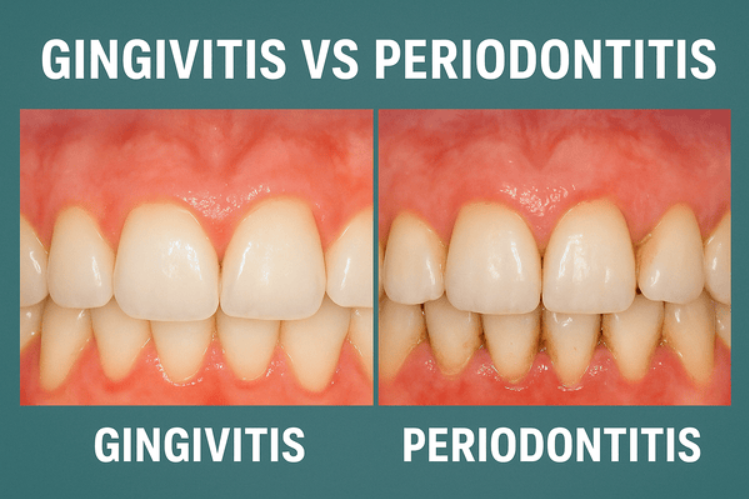
Table of Contents
- Let’s Talk Gum Disease in General
- Gingivitis: The Early Stage You Can Still Fix
- Periodontitis: When Gum Disease Gets Serious
- Quick Comparison: Periodontitis vs. Gingivitis
- Risk Factors That Push Gum Infections Along
- How Treatment Shifts between the Two
- How Do You Tell If It’s Gingivitis or Periodontitis?
- How Quickly Does Gingivitis Turn Into Periodontitis?
- Is Gingivitis Contagious?
- Can Gums Grow Back after Periodontitis?
- Can Periodontitis Be Treated At Home?
- Why You Should Care beyond Your Smile
- How Can ALIGNERCO Help with Gum Disease?
- Gingivitis Vs Periodontitis: The Finale
- FAQs
Notice blood in the sink when you spit during brushing? Many of us shrug it off. Thinking we might have brushed too hard or flossed too roughly. While that may be the case, bleeding gums don’t always mean “bad technique.”
Sometimes, it’s the first whisper of gum disease. Especially, gingivitis vs periodontitis.
Sound scary, don't they? Yet, they are the two issues people are most curious about. So, what are gingivitis and periodontitis? To answer that simply, one is a warning sign, the other is the aftermath of that warning.
That being said, there's an ongoing gingivitis vs. periodontitis debate. And it is causing a lot of confusion. So, how about we put an end to it?
Let’s Talk Gum Disease in General
Gum disease is another way of saying “gum infection.” It starts with bacteria in plaque. Skip brushing here and there, and plaque sticks. Leave it longer, and it hardens into tartar. In response to this bacteria-rich tartar, your gums start reacting.
At first, they swell, redden, maybe bleed. That’s gingivitis. If you don’t stop it, bacteria keep moving downward, wrecking the bone and tissues that hold your teeth. That’s periodontitis. Two stages of the same disease. Outcomes? Worlds apart.
Here’s more on what is periodontal disease .
Gingivitis: The Early Stage You Can Still Fix

What does gingivitis look like? Swollen gums. Red instead of healthy pink. Bleeding when you floss. Sometimes, there is bad breath that doesn’t fully go away. It usually doesn’t hurt much, which is why people ignore it.
That said, does gingivitis go away? Yes. With proper care, it can. Brushing twice daily, flossing (yes, every day), and a professional cleaning or two can reverse it. Early stage gingivitis is basically your gums waving a little warning flag. It’s the start of orthodontic decay . If you respond, you can save yourself from bigger problems.
Ignore it? That’s when things move to the next level.
Periodontitis: When Gum Disease Gets Serious

Periodontitis is what happens when gingivitis sticks around too long. Now the infection doesn’t just irritate your gums, it starts destroying the structures underneath. That’s the bone and ligaments that keep your teeth stable.
You’ll notice receding gums, maybe loose teeth, chronic bad breath, and in worst cases, pus. Mild periodontitis might just mean slightly deeper pockets forming between teeth and gums. But once you’re there, the damage is permanent. Dentists can slow it down and manage it, but they can’t reverse it like gingivitis.
This is the big difference between gingivitis and periodontitis: gingivitis is reversible, periodontitis is not.
Quick Comparison: Periodontitis vs. Gingivitis
Sometimes the simplest way to nail it down is side by side:
| Gingivitis | Periodontitis |
|---|---|
| Early gum disease | Advanced gum disease |
| Only affects gum tissue | Damages bone and ligaments |
| Reversible with brushing, flossing, and cleanings | Irreversible, only controllable |
Now, let’s compare the difference between gingivitis and periodontitis signs and symptoms.
| What are the signs of Gingivitis? | What are the signs of Periodontitis? |
| Redness | Receding gums |
| Swelling | Loose teeth |
| Bleeding | Deep gum pockets |
| Early bad breath | Constant bad breath |
| Even pus |
So, that’s the difference between gingivitis and periodontitis. Gingivitis is the early, very manageable stage of gum disease. Periodontitis is when gum disease gets serious.
Risk Factors That Push Gum Infections Along
Sure, not brushing or flossing enough is the main cause. But other things tip the balance too:
- Smoking or chewing tobacco
- Diabetes that isn’t controlled
- Hormonal shifts (puberty, pregnancy, menopause)
- Medications that dry your mouth
- Genetics. Sometimes it runs in families
Plaque is the spark, but these things pour fuel on the fire.
How Treatment Shifts between the Two

For gingivitis, treatment is simple. Professional cleanings, daily brushing, flossing, and maybe an antibacterial rinse.
For periodontitis, the playbook gets more intense. Deep cleanings under the gums (scaling and root planing), antibiotics, and in more severe cases, surgery to shrink deep pockets or rebuild tissues.
This is why catching gum disease early matters so much. Here are more ways to treat gum disease .
How Do You Tell If It’s Gingivitis or Periodontitis?
Gingivitis usually means red, swollen gums that bleed but don’t recede much. When it is periodontitis, you’ll notice receding gums, pockets, shifting teeth, or pain when chewing.
Though only a dentist can say what it is with absolute certainty. Using a probe, dentists measure the depth of gum pockets. If it is shallow. It’s gingivitis. If it is deep? Periodontitis it is. A simple test, but not one you can do at home.
How Quickly Does Gingivitis Turn Into Periodontitis?
You can’t say for sure how long it will take for gingivitis to turn into periodontitis. For some, it can take months. For others, especially with risk factors like smoking or diabetes, the change can speed up.
Is Gingivitis Contagious?
Yes. Gingivitis is contagious. It is an infection after all. The bacteria that cause gingivitis can pass through saliva. Sharing utensils, kissing, even a sip from the same cup could spread them. Now, whether it causes gingivitis in the other person depends. If they have good oral hygiene and a healthy immune response, they’ll be safe for the most part.
Can Gums Grow Back after Periodontitis?
Gums don’t grow back. Once receded, they'll stay that way. Dentists, however, have ways to bring them back. Grafts or gum tissue rebuilding procedures can get the job done. So, you won't have your natural gum back, but you'll have restored protection and a better appearance.
Can Periodontitis Be Treated At Home?
The most commonly asked question. Can I fix periodontitis myself? Sadly, the answer is you can’t. Periodontitis cannot be fixed at home, by yourself. It needs professional treatment. The procedures could include scaling, root planing, antibiotics, or surgery. At home, you can maintain results after the treatment.
Why You Should Care beyond Your Smile
Does the gum disease affect only your smile? Nope. Its damage goes beyond the oral cavity. For example, periodontitis has been linked with heart disease . Astonishing, isn't it? Here's more, gum disease is also linked with diabetes complications and respiratory infections . Thus, it won't be wrong to say that your gums are connected to your whole body.
Now, what lesson do you get from this? Don’t shrug off the signs. Don't take bleeding gums lightly and consult a dentist before things get out of hand. Prevention can be much better than a cure.
How Can ALIGNERCO Help with Gum Disease?
If you keep your teeth tartar free, you’ll cut down the chances of plaque buildup. As a result, your teeth remain clean and you’ll stay safe from gum infections. But, where does ALIGNERCO come in this?
See, teeth straightening makes cleaning easier. If you have crowded or crooked teeth, there will always be spaces that you can’t reach. So, straightening them ensures they are thoroughly cleaned. ALIGNERCO clear aligners help you get straight teeth without compromising oral healthcare.
Unlike braces, just remove the trays, clean your teeth, and put them back on. With a straighter smile, you won’t only look good, but you’ll also avoid issues like gingivitis and periodontitis.
Gingivitis Vs Periodontitis: The Finale
Gingivitis vs periodontitis, that's all from the showdown. To sum it all up, gingivitis is a warning sign. That first sign that things may turn South. Periodontitis is the damage. It’s when things have turned South. In the former, you can reverse. In the latter, you can mostly just manage.
That being said, you can prevent it from happening. Just brush, floss, and don’t ignore bleeding gums. Early stage gingivitis can be turned around. Wait too long, and you’re dealing with mild periodontitis, gum recession, and possible tooth loss.
Final words from our side. It’s easier to prevent gum disease than to fix it after real damage is done. So take your oral health seriously, and you'll dodge most of the dental issues that can disrupt your well-being.
FAQs
1. How do you tell if it's gingivitis or periodontitis?
Gingivitis shows red, swollen gums that bleed, but no bone loss. Periodontitis involves gum recession, loose teeth, and bone damage.
2. How to treat gingivitis in pregnancy?
Good oral hygiene and professional cleanings are the safest treatments. Avoid unnecessary dental drugs unless prescribed by your dentist.
3. What causes swollen gums in children?
Usually, poor brushing, plaque buildup, or irritation from braces/teething. Sometimes, a vitamin deficiency or an infection can also play a role.
4. Does periodontitis go away?
No, it doesn’t go away on its own. It can only be managed with professional dental treatment.
5. How do I get rid of gingivitis asap?
Brush and floss thoroughly, use an antibacterial mouthwash, and see your dentist for a cleaning. Early gingivitis can be reversed quickly.
6. What does stage 1 gingivitis look like?
Gums look puffy, reddish, and bleed slightly when brushing or flossing. Teeth still feel stable and healthy.
7. What does gingivitis smell like?
It often causes persistent bad breath, smelling sour or metallic due to trapped bacteria and plaque.
8. What happens if gingivitis goes untreated?
It can progress into periodontitis, causing gum recession, bone loss, and even tooth loss.
9. What deficiency causes gums to swell?
Vitamin C deficiency is a major cause, but low vitamin D or B vitamins can also contribute.
10. At what point does gingivitis become periodontitis?
When gum inflammation advances to bone and ligament damage, it is usually associated with gum pockets and loosening teeth.
11. What can be mistaken for gingivitis?
Hormonal changes, allergic reactions, canker sores, or viral infections may look similar to gum inflammation.
Citations:
Healthline. What's the Difference Between Gingivitis and Periodontitis?
https://www.healthline.com/health/dental-and-oral-health/gingivitis-vs-periodontitis
InformedHealth.org. Cologne, Germany: Institute for Quality and Efficiency in Health Care (IQWiG); 2006-. Overview: Gingivitis and periodontitis. [Updated 2023 Aug 23]. https://www.ncbi.nlm.nih.gov/books/NBK279593/
Medical News Today. What to know about gingivitis vs. periodontitis
https://www.medicalnewstoday.com/articles/gingivitis-vs-periodontitis







